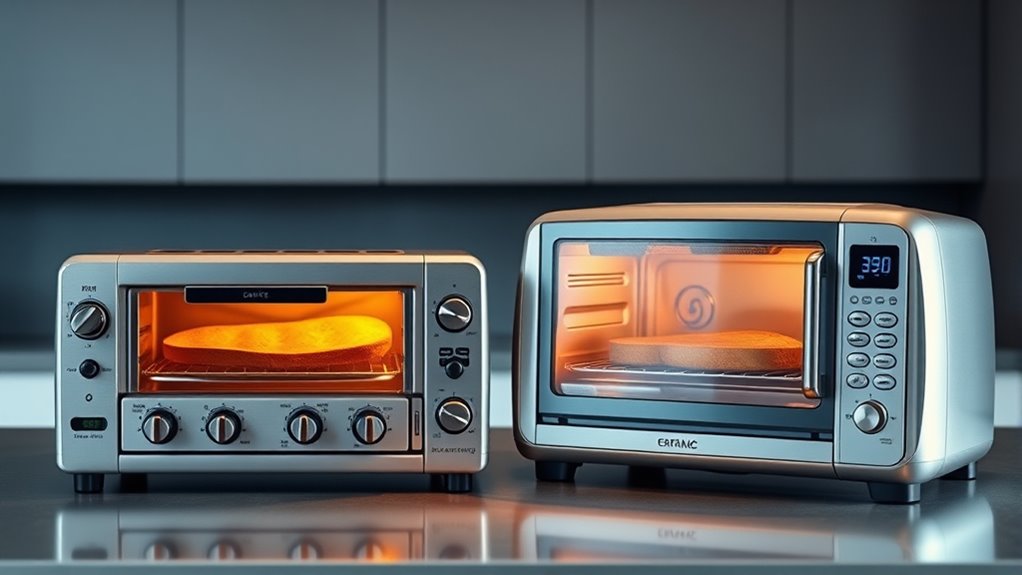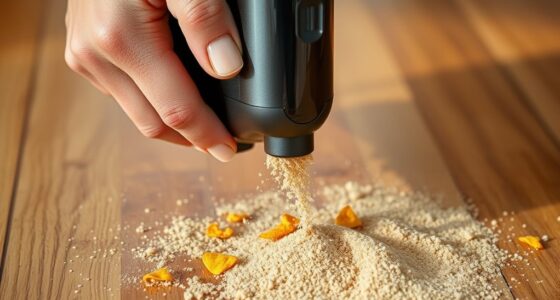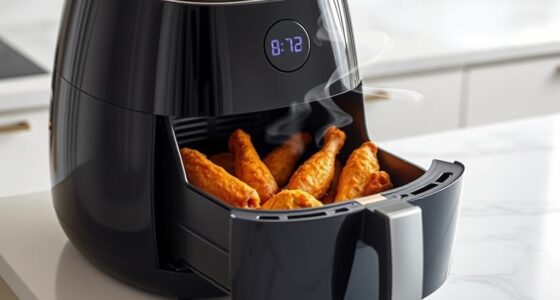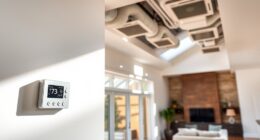Convection toaster ovens have a fan that circulates hot air around your food, cooking it faster and more evenly than traditional models, which rely only on radiant heat from their heating elements. This circulating air helps achieve crispier textures and reduces cooking times. Traditional ovens are great for even baking or broiling, but convection models offer more versatility and efficiency. If you want to understand how these differences can improve your cooking, there’s more to explore ahead.
Key Takeaways
- Convection toaster ovens feature a fan that circulates hot air, promoting faster and more even cooking compared to traditional models.
- Traditional toaster ovens rely solely on radiant heat from top and bottom elements, offering straightforward, manual control.
- Convection mode speeds up cooking times by approximately 25% and enhances browning and crispiness.
- Traditional ovens excel at even baking and top-down broiling without the need for additional fans.
- Choosing between convection and traditional depends on specific cooking needs, with convection ideal for baking and roasting.

Have you ever wondered how toaster ovens can do so much more than just toast bread? It’s because they come with different cooking methods, mainly convection and traditional modes. When you’re choosing a toaster oven, understanding these differences helps you decide which one fits your cooking style best. For example, some models allow you to switch between baking versus broiling, giving you more versatility in the kitchen. Manual controls are common in many toaster ovens, allowing you to adjust temperature, time, and functions easily, which makes cooking more precise and straightforward.
Traditional toaster ovens typically rely on radiant heat from heating elements located at the top and bottom. When you select a baking setting, the oven heats evenly, producing consistent results perfect for baking cookies, casseroles, or reheating leftovers. Broiling, on the other hand, involves direct, intense heat from the top element, ideal for quickly browning or crisping foods like melting cheese or finishing off a steak. Manual controls in these models let you fine-tune your settings; you can set the temperature and cooking time exactly how you want, giving you control over each step of the process.
Traditional toaster ovens use radiant heat for even baking and top-down heat for broiling, with manual controls for precise adjustments.
Convection toaster ovens add a fan that circulates hot air around the food, which speeds up cooking and results in more even browning. This feature is especially useful when you’re baking multiple items or cooking larger batches, as it reduces hot spots and ensures everything cooks uniformly. When comparing convection versus traditional ovens, you’ll notice convection models often cut cooking times by about 25%. Plus, the air circulation helps achieve crispy textures without needing to turn the food frequently. If you’re baking bread or roasting vegetables, convection is usually your best bet.
Many toaster ovens with convection capabilities also include manual controls, giving you the flexibility to switch between convection and traditional modes. This allows you to customize your cooking based on what you’re preparing. For instance, you might use manual controls to set a high temperature for broiling, or switch to convection for baking cookies evenly. Understanding how to toggle between these modes and adjusting manual controls accordingly is key to getting the most out of your appliance.
Additionally, advancements in AI technology, such as AI-driven solutions, are beginning to influence how appliances like toaster ovens operate, potentially offering smarter cooking options in the future. Ultimately, the choice between convection and traditional toaster ovens depends on your cooking needs. Manual controls give you the precision to experiment and perfect your dishes. Knowing when to use baking versus broiling, and how to leverage convection for better results, helps you turn your toaster oven into a versatile kitchen tool. Whether you’re reheating, baking, broiling, or roasting, understanding these differences makes cooking easier, faster, and more enjoyable.
Frequently Asked Questions
Can Convection Toaster Ovens Cook Faster Than Traditional Models?
Yes, convection toaster ovens cook faster than traditional models due to their improved cooking efficiency. The speed comparison shows convection ovens circulate hot air evenly around food, reducing cooking time. You’ll notice meals are ready quicker, making them ideal for busy schedules. With better heat distribution and consistent temperature control, convection toaster ovens save you time while delivering evenly cooked, delicious results every time.
Are Convection Ovens More Energy-Efficient Than Traditional Toaster Ovens?
Yes, convection ovens are more energy-efficient than traditional toaster ovens. They cook faster and use less energy, leading to significant energy savings over time. By reducing cooking time and heat loss, they also lessen environmental impact. You’ll notice lower electricity bills and a smaller carbon footprint, making convection ovens a smarter, eco-friendly choice for your kitchen. Plus, their efficiency helps you save resources and reduce your overall environmental impact.
Do All Toaster Ovens Have Convection Features?
Not all toaster ovens have convection features. When you compare toaster oven features, you’ll find that convection models include a fan to circulate hot air, which speeds up cooking and promotes even browning. Traditional toaster ovens lack this feature, relying solely on radiant heat. If you want quicker, more uniform results, look for convection vs traditional options, but keep in mind, not every toaster oven includes convection capabilities.
How Do Cleaning and Maintenance Differ Between Convection and Traditional Models?
Cleaning and maintenance differ mainly in protocols and schedules. With convection models, you should regularly clean the fan and vents to prevent grease buildup, which can affect performance. Traditional ovens need less frequent cleaning of internal components but still require regular crumb tray emptying and exterior wiping. Follow cleaning protocols and maintenance schedules specified in your user manual for ideal operation and to extend your toaster oven’s lifespan.
Can I Use Convection Toaster Ovens for Baking Delicate Items?
Yes, you can use convection toaster ovens for baking delicate items. Their precise oven temperature control helps prevent over-baking or burning, making them suitable for fragile baked goods like meringues or soufflés. Just remember to reduce the temperature by about 25°F compared to traditional ovens, as the convection fan circulates hot air more efficiently. This guarantees your delicate items bake evenly without risking damage.
Conclusion
Now that you see how convection toaster ovens act like a whirlwind, circulating hot air to cook evenly, you can choose wisely. Traditional models are reliable but slower, like a steady drumbeat. By understanding these differences, you’re armed with the knowledge to pick the perfect appliance—whether you want quick, even cooking or a simple, dependable machine. Think of it as choosing between a gentle breeze and a gusty wind, both capable, but each with its own personality.









